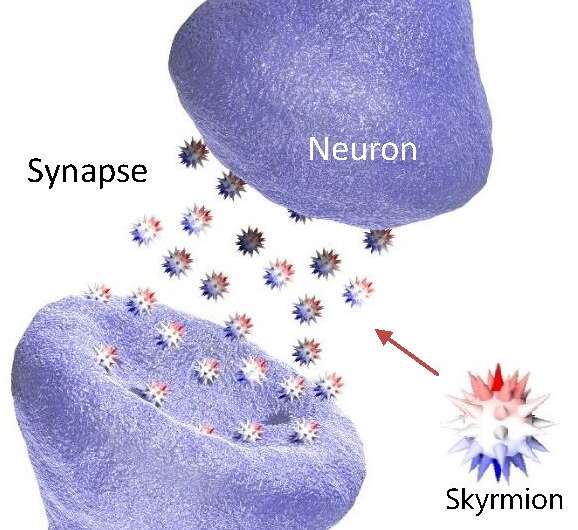March 31, 2020 feature
Using skyrmions to create artificial synapses for neuromorphic computing

Skyrmions are ultra-stable atomic objects first discovered in real materials in 2009, which have more recently also been found also to exist at room temperatures. These unique objects have a number of desirable properties, including a substantially small threshold voltage, nanoscale sizes and easy electrical manipulation.
While these properties could be advantageous for the creation of a wide range of electronics, developing functional all-electrical devices using skyrmions has so far proved to be very challenging. One possible application for skyrmions is in neuromorphic computing, which entails the creation of artificial structures that resemble those observed in the human brain.
With this in mind, researchers at the Korea Institute of Science and Technology (KIST) have recently investigated the possibility of using skyrmions to replicate mechanisms observed in the human brain. Their paper, published in Nature Electronics, shows that these ultra-stable atomic structures can be used to mimic some behaviors of biological synapses, which are junctions between neurons through which nerve impulses are passed on to different parts of the human brain.
"Since their discovery, there have been a few demonstrations of electrical manipulations of skyrmions, which suggested that they may be used to create a fully functioning device," Seonghoon Woo, one of the researchers that carried out the study and now at IBM, told TechXplore. "At the same time, we've experienced an increase in neuromorphic computing research, suggesting that an analog memory device known as a 'memristor' could be used to dramatically increase computing efficiency. As other technologies using existing analog memory are still at early stages of development, we thought that skyrmion-based memristors might be a solution, due to their ideal characteristics."
Neurons in the brain communicate across synapses using neurotransmitters, chemical substances that convey neurologic information from one cell to another. In the artificial synapses created by the researchers, each individual skyrmion acts as a neurotransmitter.
By controlling the number of skyrmions in a system using minimal electrical power, the researchers were able to mimic two mechanisms observed in biological synapses, namely their potentiation and depression behaviors, which are triggered by variations in the weight of neurotransmitters. These behaviors were replicated by eliciting the accumulation and dissipation of skyrmions, resulting in changes in the system's weight and thus in its memory.
"In our study, we explicitly compared skyrmion-based synapses with other more established technologies based on non-volatile memory, such as phase change memory or resistive memory," Woo said. "Although preliminary, our study reveals that a skyrmion-based design could have advantages in important metrics, including endurance, linearity and device-to-device variability, which are now a critical bottleneck in PRAM- or RRAM-based designs."
So far, Woo and his colleagues have tested the performance of their artificial synapses at a chip-level, in a series of simulations. They found that they performed remarkably well, particularly on pattern recognition tasks.
"Considering that most current studies on memristor-based neuromorphic computing are based on either PRAM or RRAM, I think the most meaningful achievement of our study is that we demonstrated a new way to create neuromorphic computing tools based on spin structures," Woo said.
In some pattern recognition tasks, the artificial synapses created by Woo and his colleagues achieved an accuracy comparable to that attained by other state-of-the-art computational tools. In the future, these structures could enable the development of new types of highly performing artificial neural networks (ANN).
"One of the many advantages of Skyrmions is that they can have a very small size scale—down to a single nanometer—and energy scale, in an ideal material," Woo added. "This characteristic could soon significantly reduce the operation energy for neuromorphic computing applications."
More information: Kyung Mee Song et al. Skyrmion-based artificial synapses for neuromorphic computing, Nature Electronics (2020). DOI: 10.1038/s41928-020-0385-0
© 2020 Science X Network



















